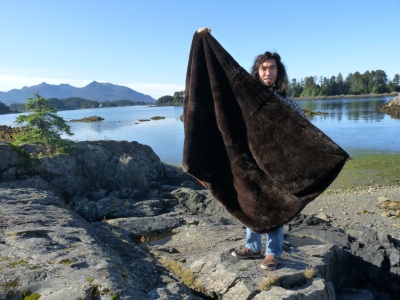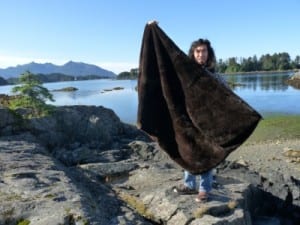Federal officials say they are trying to clarify rules for Alaskan Natives’ use of sea otters. A draft set of guidelines from the US Fish and Wildlife Service is aimed at addressing some of the confusion over what’s allowed. It’s been a frustrating situation for Native hunters and artisans who say the government has discouraged them from using the animals. Matt Lichtenstein reports:
Click here to download ifriendly audio
Ketchikan Indian Community Tribal Council member Andre LeCornu gave his opinion on the issue at a recent, joint meeting of the Southeast Regional Subsistence Advisory Council and Alaska’s Federal Subsistence Board. He blamed federal law enforcement actions for impeding Alaska Natives’ ability to make money from sea otter hunting and artwork. LeCornu noted that his grandfather worked as an otter hunter and LeCornu hunts them as well:
“I’m not an artisan. I couldn’t make a coat and I certainly can’t make some of the fancy teddy bears some of our good artists are able to do. All my sea otter have gone out to potlatch, to gifts to families, whole pelts. But other people have a right to make a livelihood, and not just subsist,” LeCornu said.
Sea otters are a federally-protected species. The Marine Mammal Protection act only allows Alaska Natives to hunt them. They may take them for subsistence and to share or sell to other Alaska Natives. They may also sell “Authentic Native articles of handicrafts and clothing,” made from otter, to non-natives. There are no bag limits or seasons, but kills must not be wasteful and they must be reported to the US Fish and Wildlife Service.
According to Special agent in charge Stan Pruszenski, law enforcement has tried to focus its efforts on hunting by non-Natives, which is completely illegal, as well as the sale of unaltered pelts to non-Natives, which the law also prohibits.
Pruszenski said, “There has been a lot of information about hides being sent overseas, smuggled out of the country to furriers and other people in other countries who want raw pelts to make their own clothing for resale.” :17
As far as crafts and clothing made from otter, Fish and Wildlife officials say they are trying to provide additional guidance on what is legal to sell outside the native community. The agency has released a set of draft guidelines for this. The key point, according to spokesperson Bruce Woods, is that the otter hide should be modified enough so a buyer can not easily return it to its original, unaltered condition without damaging it.
“You see the whole point of these is to prevent what would essentially be unaltered sea otter hides getting out of the hands of the Native handicrafters and going to someone who is non-Native who can perhaps less expensively duplicate the Native handicrafts and eliminate the markets the Native handicrafters have for these materials,” Woods says.
US Fish and Wildlife service regulations specify that items sold to non-Natives must be “significantly altered” from their natural form. But this regulatory language and the new guidelines are problematic for some hunters and artists such as Peter Williams of Sitka. Williams prefers the broader language of the law itself.
Williams says, “The marine mammal protection act exemption for Alaska Natives already gives a definition of authentic Native handicraft. It’s clear. It’s well written. It’s already in the law, in the legislation. What (sic) the US Fish and Wildlife service continues to add more regulations to that, and also in ways that are confusing, like significantly altered.”
The draft guidelines say, for instance, a sea otter blanket may not have any raw edges exposed. Williams says if you look back in history, traditional blankets had raw edges. He asserts that the US Fish and Wildlife service is undermining the intent of the law, which allows Alaska Natives to continue their customary and traditional use of marine mammals.
“They’re implementing it in a way that’s dictating to us what we can and can’t make and the problem with that is, once Alaska Natives are being told by an agency outside of our culture what we can and can’t do, what, like, in regards to what is our culture, what our traditions are, it’s no longer our culture, it’s no longer our art, it’s somebody else’s,” Williams says.
Williams has organized the Sea Otter Handicraft Coalition, a group of individuals and businesses that sew with sea otter.
“And the idea behind the coalition is to start getting the voices of people that sew and work with sea otter to get them talking about the regulations, problems we have with the regulations and solutions to the regulations,” Williams says.
The Fish and Wildlife Service originally asked people to comment on the draft guidelines by March 31st but that’s been pushed back. Agency officials now say people are welcome to submit comments up to and including the date when final guidelines come out. That may be sometime this fall. Verena Gill, a wildlife biologist with the service, says they’re also working with the Indigenous Peoples Council for Marine Mammals to set up a fall event that will address the issue.
“And we’re going to be bringing hunters and handicraft producers up to Anchorage to have a couple day workshop. And one of the focuses of the workshop is to look for input into the definition of significantly altered, how we can clarify that definition better,” Gill says.
Gill says hunters were killing an average of about 350 otters a year in Southeast up until 2009 and 20010, when that number increased to around 650. She expects it will be closer to a thousand for last year, though the totals are not in yet. You can download the draft guidelines and information on how to comment here.











